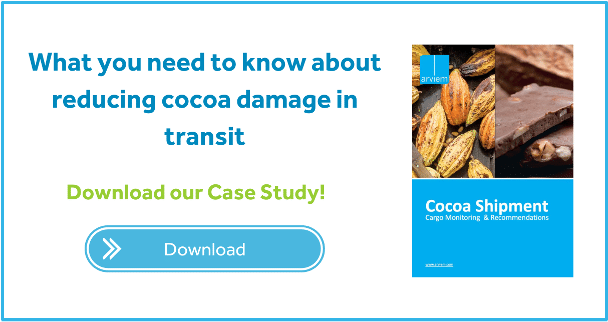Cocoa beans belong among the “most sensitive” types of perishable cargo vulnerable to unfavorable external factors. Cocoa is hygroscopic in nature, meaning it can absorb moisture from the air. When not dried properly, it also releases a lot of water vapor during transport. This sensitivity to external influences like temperature fluctuations and humidity necessitates the strict observance of all conditions during transportation to reduce cocoa damage in transit.
Cocoa beans travel a long distance to reach their final destination, often taking approximately 20 days or more. It is essential to minimize water content in the product itself, the container, and the container surface coating to preserve the quality of the goods while they are in transit. Additionally, it is also important to monitor and control the surrounding environmental conditions during the products’ journey to ensure quality and minimalize waste. Suitable packaging, appropriate desiccant use, and adjustments in line with the expected environmental conditions on various shipping routes also help maintain the quality of the goods in transit.
Why is it essential to monitor the environmental conditions of cocoa containers in transit?
Intermodal shipments of cocoa beans can be subject to “container rain.” Concerning container rain, it is a situation when condensation occurs on the coldest available surface. A combination of day-to-night temperature fluctuations, en-route delays, the high water content in the beans, or containers with wooden floors all combines to trap ambient moisture inside the shipping container – leading to container rain. When warmer air hits a colder surface (the container ceiling, as warm air rises to the top layer of the container), during fluctuation in a day and night temperatures, the moisture released can be so significant that it will be “raining” from the ceiling of the container. The condensation consequently drips down onto the cargo and causes direct damages.
Technology enabled cargo condition monitoring to lower waste and protect cocoa quality in transit
Companies source cocoa beans primarily from Ghana and Ivory Coast, so the loudest calls for traceable supply chains hail from Europe and North America. Manufacturers look to ensure quality and guarantee that the highest standards are being met when it comes to sourcing their products.
So how do companies get real-time supply chain information and better visibility into the movement and condition of their shipments? The answer lies in technology, specifically in the Internet of Things (IoT). With IoT sensors attached to shipping containers, supply-chain managers can access data to track the location and condition of assets in real-time and the security of the shipment. IoT devices can transmit real-time information on temperature, humidity, shock, and tilt. This information helps cocoa buyers to predict the quality of incoming shipments and plan risk mitigation measures or additional steps in case of potential damages.
IoT solutions can help to improve visibility at each step of the supply chain. Thanks to the advanced capabilities of IoT devices and data analytics systems, stakeholders can implement on-time decision-making and increase the precision of delivery forecasts. Thanks to real-time data combined with AI and machine learning algorithms, companies can monitor goods during shipment, predict the delivery, and forecast and mitigate risks associated with delays and quality problems. The technology can also provide insights into the best routes for avoiding delivery delays. Additionally, cargo owners can adjust the packaging and the type and volume of a desiccant used by leveraging historical data on the conditions on specific routes.
As we enter the Industry 4.0 era, digital transformation becomes essential for companies wishing to remain competitive on all fronts, including the supply chain. Technology in general, and the IoT in particular, enable real-time data analysis and visibility across the supply chain. As a result, companies can save money, reduce waste, deliver goods on time, and increase the bottom line.
A use case from Arviem’s real-time cargo condition monitoring solution
Arviem has recently completed a project with a client shipping thousands of cocoa containers from West Africa to Europe. The project’s focus was to gain more information on the container rain issues faced by the client. It was observed by the client that containers of cocoa beans regularly suffer from container rain and sweat while they are in transit. Typically, the issues were discovered when the container arrived at the destination often resulting in customer complaints. The client estimated that up to 40% of cocoa bags were damaged by container rain or container sweat.
Arviem, using container monitoring devices, gathered real-time data on the locations and conditions of the containers, including moisture and internal temperatures. The insights from the monitoring platform helped all parties with new insights into the conditions experienced inside the containers during the journey. Leveraging this data it was possible to create solutions to reduce future occurrences of problems.
The data could clearly reveal where the moisture levels were high, leading to container sweat. The client could adjust the packaging and desiccant use accordingly. The client could understand the exact lead time and respective conditions at various checkpoints. Few of the other observations from the data were:
- Moisture stress in the containers from Lagos was lower than those from Abidjan as the total amount of absorbed water was significantly lower- despite longer total lead/journey time.
- The total transit time for the 50 containers from Abidjan was 45 days
- The waiting of the containers at the loading port was 11 days.
- Waiting time of 9 days in the warehouse with temperature level >40 – 45°C inside the container,
- Relative humidity levels at the warehouse ranged between 40% and 70%
- Dew point crossed the threshold at day 23 of the transit
- Demurrage time at a transshipment port was 14 days.
- There was a diverted route – 5 days longer than a pre-planned route
Download the case study a good quality bean to bar story’ from one of the largest chocolate manufacturers!





